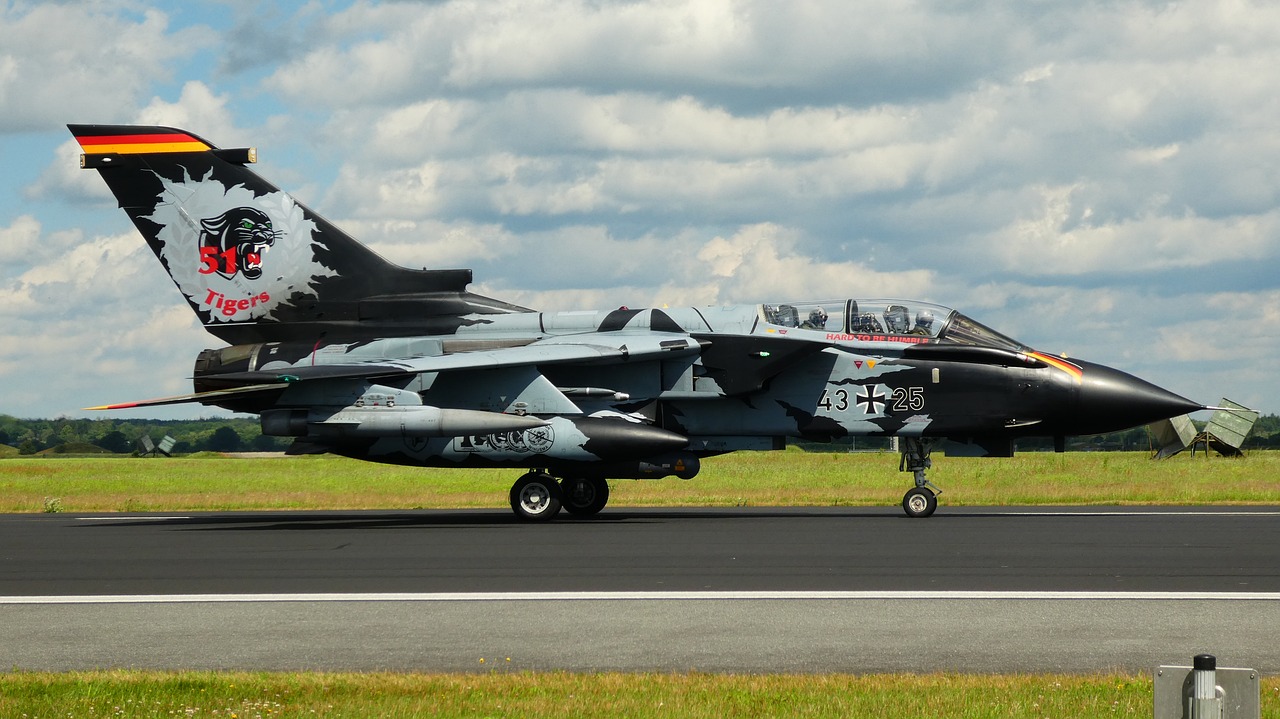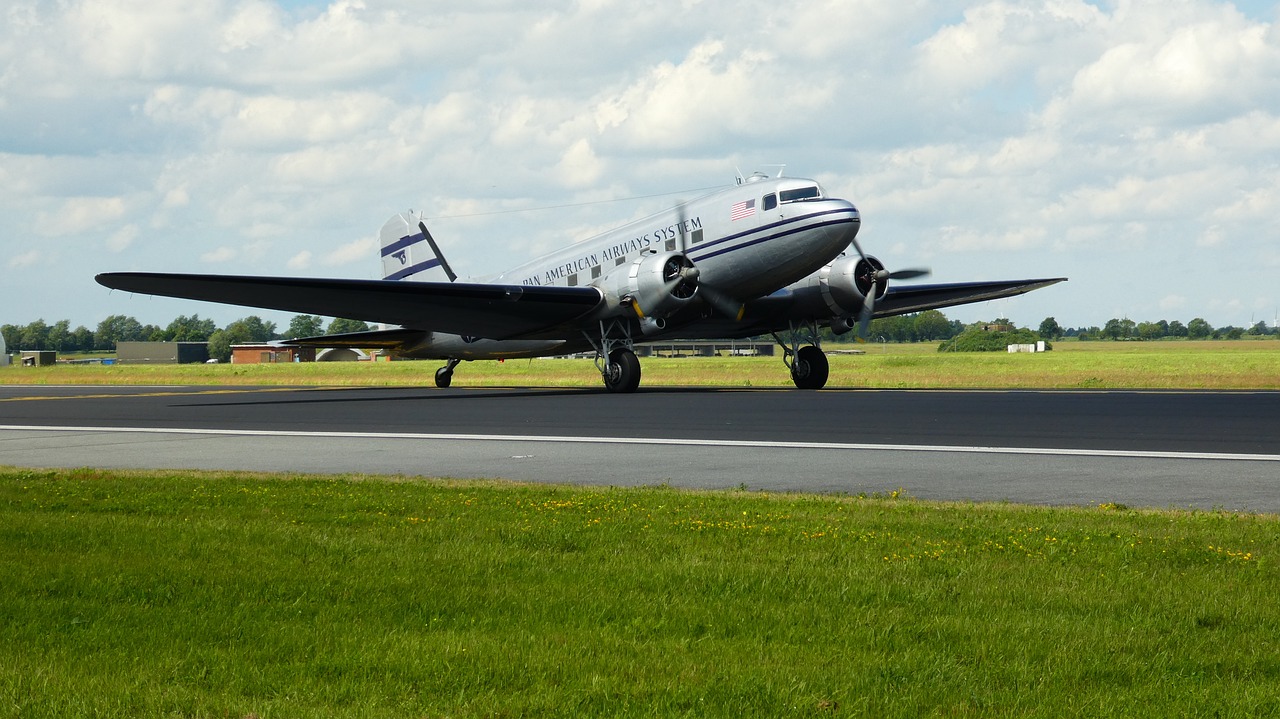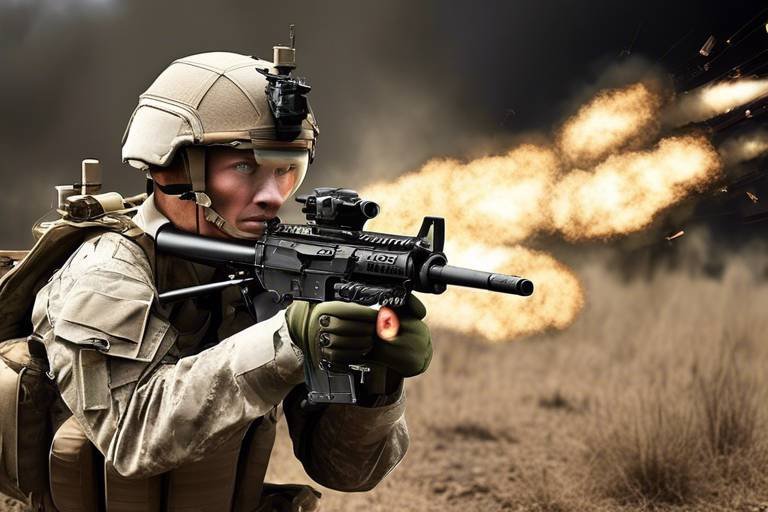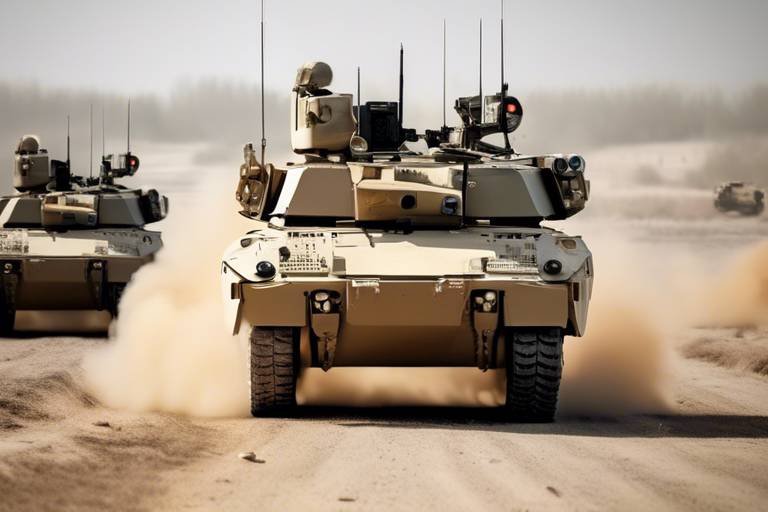Evaluating the Future of Air Defense Systems
The world as we know it is changing rapidly, and with it, the landscape of national security is evolving. As nations grapple with new technological advancements and emerging threats, the need for robust air defense systems has never been more critical. These systems serve as the frontline guardians against a variety of aerial threats, from conventional aircraft to sophisticated missiles and drones. In this article, we will delve into the evolution of air defense systems, examining their technological advancements and the implications these developments hold for military strategy and national security in an increasingly complex global environment.
Historically, air defense systems have come a long way from their rudimentary beginnings. The early days of air defense relied heavily on basic radar technology and manual interception methods. However, as threats have become more sophisticated, so too have the systems designed to counter them. Today, we witness an integration of cutting-edge technologies, such as advanced radar systems, missile interception capabilities, and automation, all of which play a pivotal role in modern warfare.
As we look to the future, it is essential to recognize that air defense systems are not just about technology; they are about strategy. The ability to adapt to new threats and challenges is paramount. For instance, the advent of hypersonic missiles and drone swarms presents a unique set of challenges that require innovative solutions and strategic foresight. Military leaders must not only invest in advanced technologies but also develop comprehensive strategies that encompass joint operations and interoperability among various military branches.
Moreover, the integration of artificial intelligence (AI) into air defense systems marks a significant turning point in how these systems operate. AI enhances threat detection and decision-making processes, allowing for quicker and more accurate responses to potential threats. As we explore the future of air defense, we must consider how these advancements will shape military strategies and national security policies.
In summary, the future of air defense systems is not merely about keeping pace with technological advancements; it is about anticipating and adapting to a rapidly changing global landscape. As we continue to evaluate these systems, it is crucial to understand the implications they hold for national security and military strategy. The stakes are high, and the need for effective air defense systems is more pressing than ever.
- What are air defense systems?
Air defense systems are military strategies and technologies designed to detect, track, and intercept aerial threats, including missiles and aircraft.
- How has technology changed air defense systems?
Technological advancements have introduced sophisticated radar systems, automated interception, and artificial intelligence, significantly enhancing the effectiveness of air defense.
- What are the emerging threats to air defense systems?
Emerging threats include hypersonic missiles, drone swarms, and cyber threats, all of which challenge traditional air defense strategies.
- Why is artificial intelligence important in air defense?
AI improves threat detection and decision-making processes, allowing for faster responses to aerial threats and enhancing operational efficiency.

Current Trends in Air Defense Technology
In the ever-evolving landscape of military technology, air defense systems are undergoing a remarkable transformation. With the rise of advanced threats and the increasing complexity of aerial warfare, nations around the world are investing heavily in cutting-edge technologies to enhance their air defense capabilities. This section delves into the latest advancements, focusing on key areas such as radar systems, missile interception, and automation, all of which are reshaping modern warfare and defense strategies.
One of the most significant trends in air defense technology is the development of sophisticated radar systems. These systems have become more accurate and versatile, allowing for better detection and tracking of various aerial threats. For instance, modern radar can now differentiate between friendly and hostile targets with remarkable precision, significantly reducing the risk of friendly fire incidents. The integration of phased array radar technology is a game-changer, enabling continuous tracking of multiple targets simultaneously, which is crucial for responding to fast-moving threats.
Moreover, missile interception technology has seen substantial advancements. The introduction of interceptor missiles that can engage targets at greater distances has dramatically increased the effectiveness of air defense systems. These missiles can now utilize advanced guidance systems and propulsion technologies to enhance their speed and accuracy, making it increasingly difficult for enemy aircraft or missiles to evade interception. The use of kinetic interceptors—which destroy incoming threats through sheer force rather than explosives—has also become a focal point for many defense programs, providing a safer and more reliable means of neutralizing threats.
Automation is another critical trend shaping the future of air defense. The incorporation of automated systems allows for faster response times and reduces the likelihood of human error during critical operations. For example, autonomous drones are now being deployed to assist in surveillance and threat assessment, providing real-time data to ground control. This not only enhances situational awareness but also allows human operators to focus on strategic decision-making rather than getting bogged down by routine tasks.
As we look forward, the integration of these technologies into cohesive air defense networks is vital. Air defense systems must not operate in isolation; instead, they should be part of an interconnected web of military assets. This integration facilitates better communication and coordination among different branches of the military, ensuring a unified response to aerial threats. In this regard, the use of advanced software platforms that allow for real-time data sharing and analysis is becoming increasingly important.
| Technology | Description | Impact on Air Defense |
|---|---|---|
| Radar Systems | Advanced detection and tracking capabilities | Improved target discrimination and reduced friendly fire |
| Missile Interception | Long-range interceptors with enhanced guidance | Increased effectiveness against fast-moving threats |
| Automation | Use of autonomous systems for surveillance and data collection | Faster response times and reduced human error |
In conclusion, the current trends in air defense technology are not just about keeping pace with threats; they are about redefining how nations approach aerial warfare. As technological advancements continue to unfold, we can expect air defense systems to become even more sophisticated, integrated, and effective. The future of air defense is not just about technology; it's about creating a comprehensive strategy that ensures national security in an increasingly complex global landscape.

The Role of Artificial Intelligence
Artificial Intelligence (AI) is not just a buzzword in the tech industry anymore; it has become a vital component in the evolution of air defense systems. Imagine having a super-smart assistant that never sleeps, constantly analyzing data and making decisions faster than any human could. That’s what AI brings to the table. With the increasing complexity of aerial threats, the integration of AI into air defense systems is transforming how nations protect their airspace. From enhancing threat detection to streamlining operations, AI is changing the game in military strategy.
One of the most significant advancements AI offers is its ability to improve threat detection. Traditional systems often rely on human operators to analyze incoming data, which can lead to delays and errors. However, AI algorithms can process vast amounts of information in real-time, identifying and classifying aerial threats with remarkable accuracy. This capability is crucial, especially when considering the speed at which modern aerial threats, such as drones and hypersonic missiles, can strike. By utilizing machine learning, these systems can learn from previous encounters, continually refining their detection capabilities to adapt to new threats.
Machine learning is a subset of AI that focuses on the development of algorithms that allow computers to learn from and make predictions based on data. In the context of air defense systems, machine learning enhances threat detection by enabling systems to recognize patterns and anomalies in aerial activity. For instance, if a drone is detected flying in a particular formation that is typical of a hostile maneuver, the system can flag this behavior as suspicious. This proactive approach significantly boosts the chances of intercepting potential threats before they can cause harm.
Another fascinating aspect of AI's role in air defense is its ability to leverage big data analytics. In today’s digital age, the amount of data generated is staggering. Air defense systems can utilize this data to optimize performance and improve reliability. By analyzing historical data, these systems can predict potential vulnerabilities and enhance response times. For example, if a system identifies a recurring failure pattern in a particular radar unit, it can prompt maintenance before a critical failure occurs, ensuring that the defense system remains operational.
Automation is perhaps one of the most transformative aspects of AI in air defense. By automating routine tasks, air defense systems can reduce human error, which is often a significant factor in operational failures. Imagine a scenario where an operator has to monitor multiple screens, analyze data, and make decisions under pressure. It’s a recipe for mistakes. However, with automation, these systems can handle repetitive tasks, allowing human operators to focus on strategic decision-making. This not only enhances operational readiness but also ensures that response times are minimized during critical situations.
Moreover, the integration of AI into air defense systems is not limited to just threat detection and operational efficiency. It also plays a crucial role in ensuring interoperability with other military assets. In modern warfare, joint operations among different branches of the military are essential. AI facilitates this integration by allowing various systems to communicate and share data seamlessly. For instance, an air defense system can work in conjunction with ground forces and naval assets to create a comprehensive defense network that can respond to threats more effectively. This synergy is vital in a world where threats can come from multiple directions and in various forms.
- What is the primary benefit of AI in air defense systems? AI enhances threat detection, decision-making, and operational efficiency, making air defense systems more effective.
- How does machine learning improve threat detection? Machine learning algorithms analyze data to recognize patterns and anomalies, allowing for real-time identification of potential threats.
- Can AI systems operate without human intervention? While AI can automate many tasks, human oversight is still crucial for strategic decision-making and managing complex scenarios.
- What role does big data play in air defense? Big data analytics allows air defense systems to optimize their performance by analyzing historical data to predict vulnerabilities and improve reliability.

Machine Learning in Threat Detection
In the ever-evolving landscape of air defense, machine learning is emerging as a game-changer, particularly in the realm of threat detection. Imagine trying to find a needle in a haystack, but this haystack is constantly shifting, filled with various threats from all directions. Machine learning algorithms act like highly skilled detectives, sifting through vast amounts of data to identify and classify aerial threats in real-time. These algorithms are designed to learn from historical data, adapting and improving their accuracy as they process new information. This capability is crucial, especially as the complexity of aerial threats increases.
One of the most remarkable aspects of machine learning in threat detection is its ability to analyze patterns. For instance, traditional systems often rely on predefined rules to identify threats, which can be limiting. In contrast, machine learning models can recognize subtle patterns that may go unnoticed by human operators or rule-based systems. By continuously learning from new data inputs, these models can adjust their threat identification criteria, making them more responsive to emerging threats.
To illustrate the effectiveness of machine learning in threat detection, consider the following table that outlines key features and benefits:
| Feature | Benefit |
|---|---|
| Real-time Data Processing | Enables immediate threat identification and response. |
| Pattern Recognition | Improves accuracy in distinguishing between genuine threats and false alarms. |
| Adaptive Learning | Continuously evolves to counter new tactics employed by adversaries. |
| Integration with Existing Systems | Enhances the capabilities of current air defense systems without complete overhauls. |
Furthermore, the integration of machine learning with big data analytics significantly enhances performance. By processing vast datasets from various sensors and intelligence sources, machine learning algorithms can identify correlations that human analysts might miss. This not only increases the reliability of threat detection but also shortens response times, allowing military forces to act swiftly in the face of danger.
As we look to the future, the role of machine learning in air defense systems will only become more pronounced. With the rise of sophisticated threats like hypersonic missiles and drone swarms, the ability to rapidly adapt and respond will be paramount. Machine learning offers a promising pathway to achieving this agility, ensuring that air defense systems remain one step ahead of potential adversaries.
In conclusion, the incorporation of machine learning into threat detection is not just a technological advancement; it represents a fundamental shift in how air defense systems operate. By leveraging the power of machine learning, military forces can enhance their situational awareness, improve decision-making processes, and ultimately safeguard national security more effectively.
- What is machine learning in the context of air defense? Machine learning refers to algorithms that allow systems to learn from data and improve their accuracy in identifying threats over time.
- How does machine learning improve threat detection? By analyzing vast amounts of data, machine learning can recognize patterns and adapt to new threats, enhancing the accuracy and speed of detection.
- What are the challenges of integrating machine learning into air defense systems? Challenges include data quality, the need for robust algorithms, and ensuring compatibility with existing systems.

Data Analysis for Enhanced Performance
In the realm of air defense systems, the role of data analysis cannot be overstated. As military operations become increasingly complex, the ability to process and analyze vast amounts of data in real-time is crucial. Imagine trying to navigate a crowded highway without a GPS; that's what air defense systems would be like without effective data analysis. With the advent of big data technologies, air defense systems can now harness information from various sources to enhance their operational capabilities.
One of the primary benefits of data analysis in air defense is its ability to optimize performance. By collecting and analyzing data from various sensors, radars, and other systems, military strategists can gain valuable insights into operational efficiency. This analysis helps in identifying patterns, predicting potential threats, and ultimately making informed decisions that can save lives and resources. For instance, when a radar detects an incoming object, data analysis can quickly assess whether it poses a threat or is merely a benign aircraft.
Moreover, data analysis plays a significant role in improving system reliability. By continuously monitoring performance metrics and system health, air defense systems can preemptively identify issues before they escalate into critical failures. This predictive maintenance approach ensures that systems are always ready for action, reducing downtime and enhancing overall readiness. The integration of machine learning algorithms further amplifies this capability, allowing systems to learn from past data and improve their predictive accuracy over time.
To illustrate the impact of data analysis, consider the following table that outlines key performance indicators (KPIs) that air defense systems track:
| Performance Indicator | Description | Importance |
|---|---|---|
| Response Time | Time taken to detect and respond to a threat | Critical for intercepting fast-moving aerial threats |
| Detection Accuracy | Percentage of threats accurately identified | Ensures that real threats are prioritized over false alarms |
| System Uptime | Percentage of time systems are operational | Higher uptime translates to better readiness |
| Data Processing Speed | Speed at which data is analyzed and decisions are made | Faster processing leads to quicker responses |
In addition to enhancing performance metrics, data analysis also facilitates better collaboration among different military branches. By sharing data across platforms and systems, air defense units can coordinate more effectively with ground forces, naval assets, and air units. This holistic approach ensures that all military operations are synchronized, maximizing the overall effectiveness of defense strategies.
However, it's important to note that the effectiveness of data analysis hinges on the quality of the data collected. Inaccurate or incomplete data can lead to misguided decisions, potentially putting military operations at risk. Therefore, investing in advanced data collection technologies and ensuring rigorous data validation processes are paramount for the success of air defense systems.
In conclusion, data analysis is a game-changer for air defense systems. By leveraging the power of big data, military forces can enhance their operational performance, improve system reliability, and foster better inter-service collaboration. As we look to the future, the integration of advanced data analytics will undoubtedly shape the next generation of air defense capabilities.

Automation in Operations
In the rapidly evolving landscape of military technology, automation in air defense operations has emerged as a game changer. Imagine a world where machines take on the heavy lifting of monitoring and responding to aerial threats, allowing human operators to focus on strategic decision-making. This shift is not just a trend; it's a necessity driven by the increasing complexity of modern warfare.
Automated systems are designed to enhance operational readiness by significantly reducing the potential for human error. When seconds count, the ability of automated systems to respond quickly and accurately can mean the difference between success and failure. These systems utilize advanced algorithms and real-time data processing to monitor the airspace continuously, identifying potential threats faster than a human could react. This capability is crucial, especially in scenarios involving multiple simultaneous threats where human response times could lag.
Additionally, automation allows for a more efficient allocation of resources. By automating routine tasks—such as surveillance and threat assessment—military personnel can dedicate their time to more complex responsibilities. This not only enhances the effectiveness of air defense operations but also improves the overall morale of the troops, who can focus on critical thinking and strategic planning instead of menial tasks.
Moreover, the integration of automated systems with existing military infrastructure is seamless. These systems are designed to be interoperable with various military assets, allowing for a unified response to threats. For instance, automated air defense systems can communicate with ground forces and naval assets, creating a comprehensive defense network that enhances situational awareness and operational effectiveness.
However, the implementation of automation is not without its challenges. There are concerns regarding the reliability and security of automated systems. As these systems become more complex, they also become more susceptible to cyber threats. Therefore, ongoing investments in cybersecurity measures are essential to ensure that these automated systems remain robust and trustworthy.
In conclusion, the role of automation in air defense operations cannot be overstated. It represents a paradigm shift in how military forces prepare for and respond to aerial threats. As technology continues to advance, the potential for automation to enhance operational efficiency and effectiveness will only grow, paving the way for a more secure and responsive air defense framework.
- What are the main benefits of automation in air defense?
Automation enhances operational readiness, reduces human error, and allows military personnel to focus on strategic tasks. - How does automation improve response times in air defense?
Automated systems can process data and respond to threats much faster than human operators, which is crucial in high-pressure situations. - Are there any risks associated with automated air defense systems?
Yes, there are concerns regarding the reliability and cybersecurity of these systems, necessitating ongoing investments in security measures.

Integration with Other Military Systems
In today's complex battlefield, the integration of air defense systems with other military assets is not just beneficial; it’s essential. Imagine a symphony where each instrument plays its part in harmony; similarly, military branches must work together seamlessly to ensure national security. The integration facilitates joint operations that leverage the strengths of various military platforms, enhancing overall effectiveness against a multitude of threats.
For instance, when air defense systems are integrated with ground forces and naval fleets, they create a comprehensive defense network capable of responding to diverse threats. This interconnectedness allows for real-time data sharing and situational awareness, which is vital in making timely decisions during combat scenarios. Each branch can communicate through secure channels, sharing intelligence and operational updates that inform tactical maneuvers on the ground and in the air.
Moreover, the interoperability of air defense systems with other military technologies—like satellite communications, unmanned aerial vehicles (UAVs), and command and control systems—is crucial. For example, UAVs can provide aerial reconnaissance, feeding real-time data back to ground-based air defense units. This information can be crucial in identifying and classifying threats before they become imminent dangers. The table below illustrates how different military systems can work together:
| Military System | Function | Integration Benefit |
|---|---|---|
| Air Defense Systems | Intercept aerial threats | Protection of ground and naval assets |
| Ground Forces | Engage enemy troops | Enhanced situational awareness |
| Naval Fleets | Control maritime threats | Multi-domain defense strategy |
| UAVs | Surveillance and reconnaissance | Early threat detection |
| Command and Control Systems | Manage operations | Coordinated military response |
However, integrating these systems is not without its challenges. Different military branches often use distinct communication protocols and technologies, which can lead to compatibility issues. Moreover, the rapid pace of technological advancements means that constant updates and training are necessary to keep all systems synchronized. It’s like trying to keep all the players in a sports team on the same page while constantly changing the playbook!
Ultimately, the successful integration of air defense systems with other military assets can significantly enhance national security. By fostering collaboration and ensuring that all branches are equipped with the latest technologies, military forces can create a robust defense posture that is capable of addressing current and future threats effectively.
- What is the importance of integrating air defense systems with other military assets?
Integration enhances situational awareness, improves response times, and creates a comprehensive defense network capable of addressing multi-domain threats. - What are the challenges of integration?
Compatibility issues between different technologies and the need for constant training and updates can hinder effective integration. - How does AI play a role in this integration?
AI enhances data sharing and threat detection, allowing for more informed decision-making across integrated military systems.

Challenges Facing Air Defense Systems
The landscape of air defense systems is rapidly evolving, but with innovation comes a set of formidable challenges that must be addressed. As nations strive to enhance their defense capabilities, they face a myriad of obstacles that could potentially hinder progress. One of the most pressing issues is the emergence of new and sophisticated threats. Traditional air defense systems, which were designed to counter conventional aerial attacks, now find themselves grappling with hypersonic missiles and drone swarms. These advanced threats move at incredible speeds and can operate in ways that make them difficult to detect and intercept, thereby complicating existing defense strategies.
Moreover, budgetary constraints play a significant role in shaping the future of air defense. Military budgets are often limited, forcing defense agencies to prioritize certain programs over others. This can lead to a situation where essential upgrades or new technologies are sidelined, leaving systems vulnerable to emerging threats. For instance, while a nation might invest heavily in one aspect of air defense, such as missile interception, other critical areas like radar technology or cyber defenses may lag behind. The delicate balance of funding allocation is crucial, and ensuring that all components of air defense systems are adequately supported is a challenge that requires careful consideration.
Another significant challenge is the rapid pace of technological advancement. As new technologies are developed, air defense systems must be modernized to keep pace. This means not only integrating cutting-edge technologies but also ensuring that older systems can work seamlessly with new ones. The complexity of such integration can lead to operational inefficiencies and increased costs. Additionally, the need for continuous training and adaptation of personnel to handle these sophisticated systems poses another layer of difficulty. The military must invest in ongoing training programs to ensure that personnel are equipped with the skills needed to operate advanced air defense systems effectively.
Furthermore, the issue of interoperability among various military branches is crucial. As air defense systems become more integrated with other military assets, such as ground forces and naval units, the challenge lies in ensuring that all components can communicate and operate effectively together. This requires a robust framework for joint operations, which can be difficult to establish amidst the differing technological standards and operational protocols of various branches. The lack of interoperability can lead to gaps in defense coverage, ultimately compromising national security.
In summary, the challenges facing air defense systems are multi-faceted and require a comprehensive approach to address. From emerging threats and budgetary constraints to the need for modernization and interoperability, each challenge presents a unique set of obstacles that nations must navigate. As we look to the future, it is clear that a proactive stance is essential to ensure that air defense systems remain effective in an increasingly complex global landscape.
- What are the main challenges facing air defense systems today?
The main challenges include emerging threats like hypersonic missiles and drone swarms, budgetary constraints, the need for modernization, and ensuring interoperability among military branches. - How do budget constraints impact air defense systems?
Budget constraints can limit the development and upgrading of air defense technologies, forcing military priorities to dictate funding allocation, which may leave some areas underfunded. - Why is interoperability important for air defense systems?
Interoperability ensures that different military branches can work together seamlessly, enhancing the overall effectiveness of defense strategies and minimizing gaps in coverage.

Emerging Threats
The landscape of modern warfare is constantly shifting, and with it comes a plethora of that challenge traditional air defense systems. As we step into an era dominated by rapid technological advancements, we must acknowledge that adversaries are not simply relying on conventional tactics anymore. Instead, they are leveraging cutting-edge technologies like hypersonic missiles and drone swarms to outmaneuver existing defense mechanisms. These threats are not just theoretical; they are becoming a reality that military strategists must grapple with on a daily basis.
Hypersonic missiles, which can travel at speeds exceeding Mach 5, present a unique challenge for current air defense systems. Their incredible speed and maneuverability make them exceptionally difficult to track and intercept. Traditional radar systems, which are designed to detect slower-moving threats, often struggle to identify hypersonic projectiles before they reach their targets. This creates a pressing need for advanced detection systems that can keep pace with these new types of threats. Imagine trying to catch a bullet with your bare hands—this is the level of challenge posed by hypersonic technology!
On the other hand, drone swarms represent another layer of complexity in air defense strategies. These swarms consist of numerous small, unmanned aerial vehicles (UAVs) that can operate in unison, overwhelming traditional defense systems through sheer numbers. The ability of these drones to communicate and coordinate with one another makes them a formidable adversary. In essence, they can mimic a flock of birds, evading detection while simultaneously launching coordinated attacks. This necessitates a shift in thinking; air defense systems must evolve from focusing solely on individual threats to addressing the challenges posed by collective action.
To effectively respond to these emerging threats, military organizations are exploring various strategies:
- Advanced Radar Systems: Developing radar technologies that can detect hypersonic speeds and identify multiple targets simultaneously.
- Artificial Intelligence: Implementing AI-driven systems for real-time data analysis and threat prioritization.
- Interoperability: Ensuring that air defense systems can work seamlessly with other military assets to create a unified defense strategy.
Moreover, the integration of cybersecurity measures into air defense systems is becoming increasingly vital. As drones and missile technologies become more sophisticated, so too do the methods employed by adversaries to disrupt defense networks. Securing communication channels and ensuring that systems can withstand cyber-attacks is essential for maintaining operational integrity. In this ever-evolving battlefield, the stakes are high, and the costs of inaction could be devastating.
In summary, the emergence of hypersonic missiles and drone swarms represents a significant challenge for air defense systems worldwide. As military forces adapt to these threats, they must embrace innovation and collaboration, ensuring they remain one step ahead of those who seek to exploit vulnerabilities in their defenses. The future of air defense will not only depend on technology but also on the strategic thinking and adaptability of military leaders in the face of these daunting challenges.
Q: What are hypersonic missiles?
A: Hypersonic missiles are weapons that travel at speeds greater than Mach 5, making them extremely difficult to detect and intercept.
Q: How do drone swarms operate?
A: Drone swarms consist of multiple unmanned aerial vehicles that communicate and coordinate with each other to perform tasks, often overwhelming traditional defense systems.
Q: What technologies are being developed to counter these threats?
A: Advanced radar systems, artificial intelligence, and enhanced cybersecurity measures are being developed to better detect and respond to emerging threats like hypersonic missiles and drone swarms.

Budgetary Constraints and Priorities
In the realm of air defense systems, budgetary constraints are a significant hurdle that governments and military organizations face. As the global landscape becomes increasingly volatile, the need for advanced air defense technologies is paramount. However, the reality is that military budgets are often limited and must be allocated across various sectors, including personnel, training, and equipment. This creates a scenario where air defense initiatives might not receive the funding they desperately need, leading to a potential gap in national security.
One of the primary challenges is prioritizing which systems and technologies to invest in. With emerging threats such as hypersonic missiles and drone swarms, the military must make tough decisions about where to allocate resources. For instance, while investing in cutting-edge radar systems and missile interception technologies is crucial, it often comes at the expense of other necessary upgrades. The dilemma lies in balancing immediate needs with long-term strategic goals. It’s like trying to fill a bucket with holes; no matter how much you pour in, if you don’t fix the holes, you’ll never fill it up.
Moreover, the bureaucratic nature of military funding can complicate matters further. Often, funding is tied to political agendas and lobbying efforts, which can skew priorities away from genuine security needs. This is where strategic planning becomes essential. Military leaders must advocate for air defense funding by presenting clear, data-driven arguments that demonstrate the necessity of these systems in safeguarding national interests. They must also ensure that air defense is integrated into broader military strategies, emphasizing its role in joint operations and overall defense posture.
To illustrate the impact of budgetary constraints, consider the following table that outlines the allocation of military budgets across various sectors:
| Sector | Percentage of Total Budget |
|---|---|
| Personnel | 30% |
| Equipment and Technology | 25% |
| Training and Readiness | 20% |
| Research and Development | 15% |
| Operational Costs | 10% |
This table highlights how a significant portion of military budgets is consumed by personnel and operational costs, leaving limited resources for critical areas such as research and development of air defense systems. As a result, military planners are often forced to make compromises that could affect the effectiveness of air defense capabilities.
In conclusion, navigating budgetary constraints while prioritizing air defense systems is a complex task that requires foresight, strategic planning, and advocacy. As threats evolve, military leaders must ensure that air defense remains a top priority, not just in funding but in overall military strategy. After all, in the world of defense, being proactive is far more effective than being reactive.
- What are the main challenges facing air defense systems today?
The main challenges include emerging threats like hypersonic missiles and drone swarms, budgetary constraints, and the need for modernization. - How does budget allocation affect air defense capabilities?
Limited budgets can restrict the development and procurement of advanced air defense technologies, impacting overall national security. - Why is artificial intelligence important in air defense?
AI enhances threat detection, decision-making processes, and operational efficiency, making air defense systems more effective against modern threats.
Frequently Asked Questions
- What are the latest advancements in air defense technology?
Recent advancements in air defense technology include enhanced radar systems, improved missile interception capabilities, and the integration of automation. These technologies are crucial for modern warfare, allowing for quicker response times and more effective defense strategies against evolving threats.
- How is artificial intelligence transforming air defense systems?
Artificial intelligence is revolutionizing air defense by enhancing threat detection and decision-making processes. AI algorithms analyze vast amounts of data in real time, allowing military personnel to make informed decisions quickly, thus improving operational efficiency and readiness.
- What role does machine learning play in threat detection?
Machine learning plays a vital role in improving the accuracy of threat detection. By using algorithms that learn from historical data, air defense systems can identify and classify aerial threats more effectively, ensuring a faster and more reliable response to potential dangers.
- How does data analysis enhance the performance of air defense systems?
Data analysis allows air defense systems to optimize their performance by providing insights into system reliability and response times. By analyzing patterns and trends, military strategists can make adjustments that enhance overall effectiveness and operational readiness.
- What challenges do air defense systems currently face?
Air defense systems face several challenges, including emerging threats like hypersonic missiles and drone swarms, budget constraints that limit development, and the need for modernization to keep pace with rapid technological advancements. These factors complicate the effectiveness of current strategies.
- How are budgetary constraints affecting air defense initiatives?
Budgetary constraints often limit the development and modernization of air defense systems. Military priorities influence funding allocations, which can hinder the advancement of crucial technologies necessary for maintaining effective defense capabilities against evolving threats.
- What is the significance of integrating air defense systems with other military assets?
Integrating air defense systems with other military assets is essential for comprehensive defense strategies. This integration enhances joint operations and interoperability among different branches of the military, allowing for a more coordinated and effective response to threats.



















